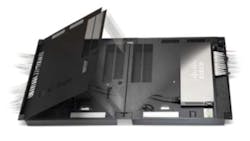Rosenberger: Active consolidation point setup saves energy
Rosenberger Optical Solutions and Infrastructure (Rosenberger OSI) recently announced that according to test results, the FTT-ACP (fiber to the active consolidation point) concept achieves up to 50% energy savings in current building cabling projects. “This is made possible by the PerConnect EcoFlexIT complete system,” the company said, “which combines active and passive components and, thanks to the Active Consolidation Point [ACP], combines floor distributor, switch and passive collection point.”
“As technology continues to advance rapidly, the IT community must ensure that progress is geared toward serving the individual and society in an efficient and sustainable manner,” said Stefan Wiener, product manager, LAN, at Rosenberger OSI.
The company pointed out, “In the IT industry, the topic of ‘sustainability’ is increasingly coming to the fore through ‘green IT.’ Resource-conserving components with low energy consumption and environmentally friendly materials are currently the number-one trend topic.
“Although IT is part of the problem of increasing energy demand and CO2 emissions, sustainable and efficient IT is the key to the solution,” Rosenberger OSI continued. “Even modern office and building cabling cannot escape technical progress. Maximum flexibility, sustainability and cost-effectiveness as well as simple adaptation to future requirements are of decisive importance. Rosenberger OSI has developed its FTT-ACP concept for this application scenario—an innovative, redundant Ethernet cabling concept that can be used flexibly and offers high potential for cost savings.”
The ACP integrates a passively cooled switch, which conserves resources, the company also noted. It calculates that conservation at approximately 50%. “The FTT-ACP concept is also energy-saving during production,” Rosenberger OSI added. “The production of the components requires only 31.25% of the energy required for the manufacture of copper cables in a classically structured cabling system.”
The FTT-ACP setup or architecture reduces the number of copper cables in a LAN, the company said. “According to current calculations, the raw material savings for production are an impressive 68.75%,” the company added. “In addition, the ‘gray energy’ generated by production, transport, storage and disposal can be drastically reduced.”
Wiener concluded, “With PerConnect EcoFlexIT, companies can implement efficient building cabling management that makes modern workstations fit for the digital future.”
Read Rosenberger OSI's white paper "FTT-ACP: Ready for the future in building cabling."
